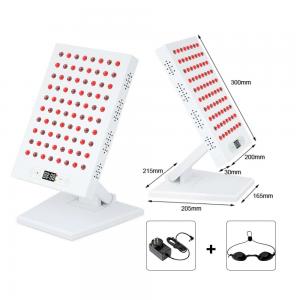

Add to Cart
| Product name | MAKSDEP Red Light Therapy Device |
| Model No. | BXA400 |
| Light Size | 300*200*30MM |
| Light Color | Red+Infrared |
| LED Quantity | 80pcs |
| Flicker | No Flicker/Flicker-Free |
| Lifespan | 100,000 hrs |
| Power | 50w |
| Input Voltage | DC24V |
| Driver | With adaptor, AC100-240V 50Hz |
What Are the Uses of Light Therapy?
Light therapy, also known as phototherapy or photobiomodulation,
has gained prominence as a versatile and non-invasive approach to
address various health and wellness concerns. This therapeutic
technique involves exposure to specific wavelengths of light, and
among these, the combination of 660nm red light and 850nm red
infrared light has demonstrated notable benefits for the skin and
overall well-being. In this comprehensive exploration, we will
delve into the diverse uses of light therapy, focusing on the
assistance that 660nm red light and 850nm red infrared light can
provide to the skin and the human body.
This visible red light penetrates the skin's surface and stimulates
cellular activity.
Known for its ability to promote collagen production, which is
crucial for skin elasticity and the reduction of fine lines and
wrinkles.
Addresses skin concerns such as acne, promoting healing and
reducing inflammation.
850nm Red Infrared Light:
Beyond the visible spectrum, red infrared light penetrates deeper
into the skin and underlying tissues.
Assists in enhancing blood circulation, promoting oxygen and
nutrient delivery to cells, and supporting overall tissue repair.
Known for its potential to alleviate muscle soreness, joint pain,
and aid in recovery.
Diverse Uses of Light Therapy:
1. Skin Rejuvenation and Anti-Aging:
Light therapy, particularly with the use of 660nm red light, has
become a popular choice for skin rejuvenation and anti-aging. By
stimulating collagen production, it helps maintain skin elasticity,
reduce wrinkles, and promote a more youthful complexion. Regular
sessions contribute to a brighter and firmer skin appearance.
2. Acne Treatment:
The antibacterial properties of 660nm red light make it effective
in treating acne. This wavelength targets the sebaceous glands,
reducing oil production and inflammation. Additionally, it promotes
the healing of existing blemishes and prevents future breakouts,
offering a non-invasive alternative for individuals with acne-prone
skin.
3. Wound Healing and Tissue Repair:
Both 660nm red light and 850nm red infrared light contribute to
wound healing and tissue repair. The stimulation of cellular
activity accelerates the recovery process, making light therapy a
valuable tool in promoting faster healing for cuts, bruises, and
other skin injuries.
4. Muscle Recovery and Pain Management:
The deeper penetration of 850nm red infrared light makes it
effective for addressing muscle soreness and joint pain. Athletes
and individuals recovering from injuries often use light therapy to
promote faster muscle recovery, reduce inflammation, and manage
pain associated with various conditions.
5. Seasonal Affective Disorder (SAD):
Light therapy has proven effective in managing Seasonal Affective
Disorder, a type of depression that occurs at specific times of the
year, often in the winter months when sunlight exposure is reduced.
Exposure to bright light, mimicking natural sunlight, helps
regulate mood and alleviate symptoms of SAD.
6. Sleep Disorders and Circadian Rhythm Regulation:
Light therapy is employed to regulate sleep patterns and address
sleep disorders. Exposure to light, particularly in the morning,
helps reset the circadian rhythm, promoting alertness during the
day and improving sleep quality at night.
7. Psoriasis and Other Skin Conditions:
Light therapy is utilized in the treatment of psoriasis and certain
skin conditions. Controlled exposure to specific wavelengths can
help manage symptoms, reduce inflammation, and promote healthier
skin in individuals with chronic skin disorders.
8. Mood Enhancement and Mental Wellness:
Beyond its physical benefits, light therapy positively influences
mood and mental wellness. Exposure to light is thought to influence
neurotransmitters like serotonin, contributing to improved mood and
overall mental well-being.
